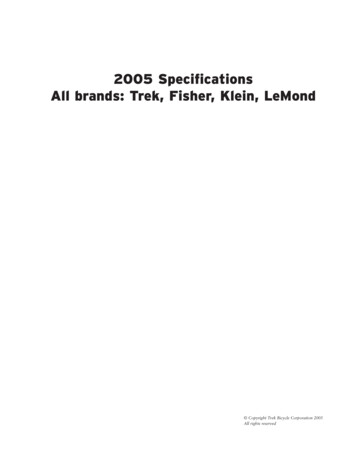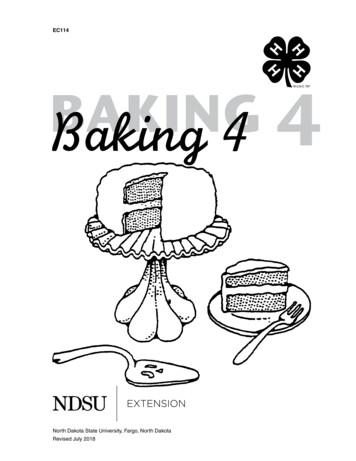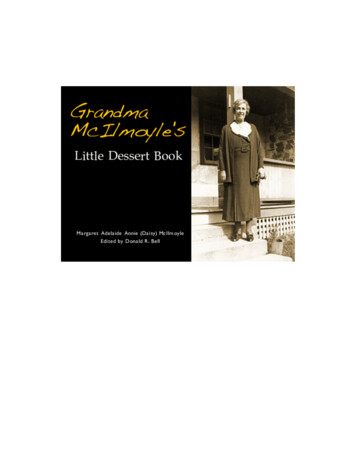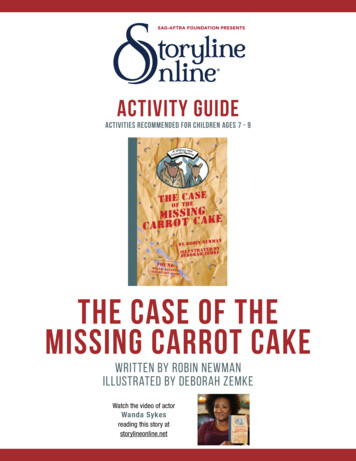
Transcription
How to Cut a Cake FairlyAuthor(s): Walter StromquistSource: The American Mathematical Monthly, Vol. 87, No. 8 (Oct., 1980), pp. 640-644Published by: Mathematical Association of AmericaStable URL: http://www.jstor.org/stable/2320951 .Accessed: 28/08/2011 23:24Your use of the JSTOR archive indicates your acceptance of the Terms & Conditions of Use, available at ms.jspJSTOR is a not-for-profit service that helps scholars, researchers, and students discover, use, and build upon a wide range ofcontent in a trusted digital archive. We use information technology and tools to increase productivity and facilitate new formsof scholarship. For more information about JSTOR, please contact support@jstor.org.Mathematical Association of America is collaborating with JSTOR to digitize, preserve and extend access toThe American Mathematical Monthly.http://www.jstor.org
640[OctoberWALTER STROMQUISTlinesis not acute; we maytake thisanglea to be at a vertex(h,k) in thefirstquadrant.Thena , 2 impliesthath k 2, and thisin turnimpliesthatthe area of C in thefirstquadrantdoes notexceed1. Hence A(C) 4.B-6. (22, 4, 3, 0, 0, 0, 1, 0, 10,4, 42, 119)Let X (x1, * ,xn) and Y (yi' * ,Yn). Also leta bi be eithersquarerootOfZ2 .ab X*Y x1ly1 ** xjyn and.a2-b2 jjXjj2 jjyjj2 (x2 . X,2) (y2 . z,2.Then Y2The Cauchy-Schwarzinequalitytells us that IX. YI S jIXII* 11Yll and hence lal IlbiSthe assumptionthat lal lXII would implythat IbI IIYII. This andIIXII IIYI. Therefore,would yield a2 I XII and thusthe contradictionIaI IIXI. Hence thea2 H1XHI2-H1YH12 b2thisSinceassumptionis falseand r IaIIX X1.impliesthe desiredIiIX112? (1X11 *** IXnl)2,rS IxII . lXnlMATHEMATICAL NOTESEDITED BY DEBORAH TEPPER HAIMO AND FRANKLINTEPPER HAIMoofMathematicalDeborah TepperHaimo, DepartmentMaterialforthisdepartmentshouldbe sentto ProfessorSciences,Universityof Missouri,St. Louis, MO 63121.HOW TO CUT A CAKE FAIRLYWALTER STROMQUISTDaniel H. WagnerAssociates,StationSquare One,Paoli, PA 19301In thisnotewe provethata cake can be dividedfairlyamongn people,althougheach mayhave a differentopinionas to whichpartsof thecake are mostvaluable.It can be done evenifchoices!"fair" means thatall peoplemustreceivetheirfirstIn a simplerversionof theproblem,a divisionis regardedas "fair"ifall people("players")are satisfiedthateach has receivedat least l/n of thecake. For thisversion,thereis a simpleand practicalsolution,attributedby Steinhaus[1] to Banach and Knaster.MartinGardnerdescribesthecase n 3 in his newestbook [2]:"One personmoves a largeknifeslowlyover a cake. The cake may be any shape, but the knifemustincreasesfromzero to themaximumamount.Asmove so thattheamountof cake on one side continuouslysoon as any one of the threebelieves thatthe knifeis in a positionto cut a firstslice equal to 1/3 of thecake, he/she shouts'Cut!' The cut is made at thatinstant,and thepersonwho shoutedgetsthepiece. Sincehe/she is satisfiedthathe/shegot 1/3,he/she dropsout of thecuttingritual.In case two or all threeshoutthepiece is givento any one of them.'Cut!' simultaneously,"The remainingtwopersonsare, of course,satisfiedthatat least 2/3 of thecake remain.The problemisthusreducedto thepreviouscase ."This clearlygeneralizesto n persons."versionof the problem,in whicha divisionisGardnerthendescribesthe more difficultregardedas "fair"onlyifall playersconsidertheirownpiecesto be at leastas valuableas anyofall playersgettheirfirstchoices.The proceduredescribedabove causetheplayerwho claimsthefirstpiece mayhave a changeof mindafterseeing the remainingpieces. When n 3, we propose a new procedureto meet thisobjection:
1980]641MATHEMATICAL NOTESA refereemovesa swordfromleftto rightoverthecake, hypotheticallydividingit intoa smallleftpieceand a large rightpiece. Each playerholds a knifeover what he considersto be the midpointof the rightpiece. As the refereemoves his sword,the playerscontinuallyadjust theirknives,always keepingthemparallel to the sword (see Fig. 1). When any player shouts "cut," the cake is cut by the sword and bywhicheverof theplayers'kniveshappensto be themiddleone of thethree.FIG.1.The playerwho shouted"cut" receivesthe leftpiece. He mustbe satisfied,because he knew what allthreepieces would be whenhe said theword.Then theplayerwhoseknifeended nearestto thesword,ifhedidn't shout"cut," takes the centerpiece; and the playerwhose knifewas farthestfromthe sword,if hedidn't shout "cut," takes the rightpiece. The playerwhose knifewas used to cut the cake, if he hasn'talreadytakentheleftpiece,willbe satisfiedwithwhicheverpiece is leftover.If tiesmustbe broken-eitherbecause two or threeplayersshout simultaneouslyor because two or threeknivescoincide-they may bebrokenarbitrarily.This proceduredoes not generalizeto largern. JohnSelfridge,JohnConway,and RichardGuy,in theirresearchon thefairdivisionofwine,havediscovereda moreelegantalgorithmforn 3, but it, too, failsto generalize.In thisnote we shall be contentwitha nonconstructivevalid forall n.existencetheoremhas alreadyappearedin thisOne existencetheorem,operatingon quitedifferentprinciples,MONTHLY [3]. Dubins and Spanier(in an articlewiththesame titleas thisnote) assumedthateach player'spreferencesare definedby a yfinitenumberof measures(includingthoseof theplayersand thoseof thekibitzersasof thecake inton partsthatare equal accordingto all of them-easures.well),thereis a partitionthe power of Lyapunov'sTheoremand otherThis was one of ues.Unfortunately,theirresultdependson a liberaldefinitionof a"piece" of cake,in whichthepossiblepiecesforman entirea-algebraof subsets.A playerwhohopes onlyfora modestintervalof cake maybe presentedinsteadwitha countableunionofcrumbs.In thisnotewe shalladheremorecloselyto theoriginalmodelby imposinga rigidstructureon thewaysin whichthecake maybe cut.In particular,we shallinsistthatit be cutby (n - 1),planes,each parallelto a givenplane.The possiblecutscan thenbe representedby numbersinx . ,Xn- ) suchthattheinterval[0,1]; and thepossibledivisionsof thecake,byvectorsx (XI X21,.O xI6x2 xn-I 1. By conventionlet x0 0 and xn l, so that the ith piece is theinterval[xi-,xi]. The possibledivisionsforma compactsetin Rl1, whichwe call thedivisionsimplex,Sv f(XI.XY .1 lnX1 *'. Xn1
642[OctoberWALTER STROMQUISTSee Fig. 2. S has the shape of an (n-l)-simplex with verticesat v1 (1, 1,., 1),v2 (0, 1,., 1),.,v (0,0,. ., 0). The vertexvi representsthedivisionin whichtheithpiece is thewholecake,and thefaceoppositevi,whichwe shallcall Si, consistsof divisionsforwhichtheithpieceis empty.V2 (O, 1)S3VI (1, 1)VIV2A21A1iSIV3 (O, 0)FIG. 2. When n 3,S C R2.V3FIG. 3. Preferencesof thejth player.We allow greatgeneralityin theplayer'spreferences.We assumethatthechoiceforthejthplayeris based on a real-valuedevaluationfunctionf1,whichgivesthevalue of theithpiece intermsofxI,.-,x,,.-1(and i). Thus thevalueof theithpieceto thejthplayeris denotedbyf(x, i).Intuitively,one expectsf(x, i) to dependonlyon xi-1 and xi,but theadded generalitycomesatno extracost.For a givenx, we say thatplayerjpreferstheithpiece iff1(x,i) f1(x,k) forall k. For someto twoor more"preferred"divisionsa playermaybe indifferentpieces.The divisionis fairifeach playercan be givena preferredpiece.We assumethateachf is a continuousfunctionof x. We mustalso assumethatno playereverprefersan emptypiece of cake.THEOREM. Under theseassumptions,thereis a divisionx and a way to assign thepieces to theplayerssuch thatall playersprefertheirassignedpieces.theithProof.For each i,j, letA. be thesetofdivisionsx E S forwhichthejth playerpreferspiece.Fromthecontinuityof thefunctionsf we knowthateachA. is closed.For eachj, thesetsA. coverS. The assumptionthatno playerprefersan emptypiece impliesthatA. has emptyintersectionwiththefaceSi foreach i,j. The setsA., provideall theinformationwe need aboutSee3.theplayers'preferences,so we shallnotreferagainto thefunctionsFig.fj.DefineB. n k,i(S - Akj).Thus B. is e ith piece. TypicallyB. is the interiorof Au,,but thatis not necessary.Each B., is open(relativeto S). Note that,for a givenj, the sets B. do not cover S; the uncoveredpartto twoor moreacceptable(S - U iBij)consistsof divisionsforwhichthejth playeris indifferentpieces.Now defineUi ujBy. Thus Ui is thesetof Note thateach Ui is open (as always,relativeto S) and thatUi does notintersectS,.We now dividetheproofintotwocases.Usual Case: Thesets U;coverS. In thiscase we relyon a topologicallemma.LEMMA. Suppose an (n - 1)-simplex S is covered by n open sets U1,., U-,, such that no Uintersectsthe correspondingface Si. Then the commonintersectionof U1,., U, is nonempty.To see how thislemmaprovesthe theorem(in the usual case), choose a divisionx in theof the Ui's. Since x E Ui for each i, everypiece will be the er.Sincethereare exactlyenoughpiecesto go around,all playerscan taketheirownfirst-choicepieces.
1980]643MATHEMATICAL NOTESProofofLemma.We continueto regardS as a subsetof thevectorspace RFO"-1,and use viand Si as before.WriteaS fortheboundaryof S. For each i, and foreach x E S, letdi(x) be thedistancefromx to the closed set (S - U), and defineD(x) 2idi(x). Since x E Ui forsome i,definef:S- S bysomed,(x) is positiveand so is D(x). We maythereforef(x) D vi()i(doff to aS is a functionThe restrictionfo: as8-)s thattakeseach face Si to itself.Hence wefomaydefinemapsf,: as- as byf,(x) tx (1- t)f(x).Thesemapsdefinea homotopybetweenon Ms.Thereforeand theidentityfo cannotbe extendedto a map fromS to Ms.In particular,of S.theinteriorsincef is an extensionoffo,itsimagemustintersectFinally,ifx is any pointinf -1 (intS), thenx is in each Ui.Unusual Case: The sets Ui do not cover S. This case is unusual because it depends on acoincidence:ifx is notin any U,,thenit is notin anyB. foranyj, so it mustleaveeveryplayerto two or more acceptablepieces. But thisis not impossible.For example,if allindifferentthe"coincidence"is certainto occur.playershave identicalpreferences,thesetsWe willapproximatein thiscase is to modifytheplayers'preferences.Our strategyAi by setsA',fwhichare more orderlyand forwhichthe "coincidence"does not occur. Bywereapplyingthelemmawe shallfinda divisionthatwouldbe atesolutionswilldescribedby the sets A,. As the approximationsconvergeto a divisionthatis fairaccordingto theactualpreferences.We startby choosingirrationalnumbersaj,. ,a, one for each player,thatare linearlyfromaj isovertherationals.We say thata numberis relatedto aj ifitsdifferenceindependentbutno numbercan be relatedto bothaj and ak ifrational.Numbersrelatedto aj are densein Rlt,j#4k.Let M be a (large)integer.AX,as follows.Divide S into cells by all planes of the form{xlXk For eachj, constructwithitsboundary,is partof L. A cell,together(L/M) aj) fork 1,.,n and forall riptsmallestifiisA!,theVIV2A2'jAl V3thepreferences.FIG. 4. ApproximatingThe importantpropertiesof A,j are (1) everypoint on the boundaryof A' has somecoordinaterelatedto aj, and (2) A,JapproximatesAu in thesensethateverypointA' is within\bi/M of somepointofAi.ofAs.-and defineA)-this is equal to theinteriorNow foreach i,j, defineB,j nk7#i(S-AUi' ujB,j. As before,thesetsUi'are openand (ifM has beenchosenlargeenough)Ui'does notintersectS,. To provethatthesets Ui' coverS, notethatifx is notin any Ui',it mustnotbe inany B,J,so it mustbe on theboundaryof someA,j foreveryj. That meansthatx musthave acoordinaterelatedto each of the aj's. But this is impossible,because x has only (n-1)and each maybe relatedto onlyone aj.coordinates,
644LEON GERBER[OctoberTherefore,we mayapplythelemmato finda pointin thecommonintersectionof thesetsUi'.We call it XM. If thecake is dividedaccordingto XM, thepiecescan be assignedto theplayersinsucha way thatifthejth playerreceivestheithpiece,thenXM is containedin A,,and is withinNfi /M ofA .As M increases,we can generatea sequenceof divisions{XM}. Since S is compact,we canfind a subsequencethat convergesto some divisionx E S; and by reducingto anothersubsequenceifnecessary,we can guaranteethattheassignmentofpiecesto playersis thesameforeach divisionXM in thesubsequence.Cut thecake accordingtox and assignthepiecesto theplayersas fortheseXM. Thenifthejthplayerreceivestheithpiece,x mustbe arbitrarilyclosetoA . SinceAi, is closed,thisimpliesthatx E A., and thejth playerpreferstheassignedpiece.References1. H. Steinhaus,Sur la divisionpragmatique,Econometrica(supplement),17 (1949) 315-319.2. MartinGardner,aha! Insight,ScientificAmerican/W.H. Freeman,San Francisco, 1978,p. 124.3. L. E. Dubins and E. H. Spanier,How to cut a cake fairly,thisMoNTHLY, 68 (1961) 1-17.NAPOLEON'S THEOREM AND THE PARALLELOGRAM INEQUALITY FORAFFINE-REGULAR POLYGONSLEON GERBERDepartmentofMathematicsand ComputerScience,St. John'sUniversity,Jamaica,NY 11439A well-knowntheorem,firstprovedin [2] butcreditedto Napoleon,readsas follows:Constructon thesides of any formtheverticesofan equilateraltriangle.A lesser-knowntheoremof Thebault[11] (whichis easilyobtainedas a corollaryof VanAubel's theorem[6],[1]) states:Constructon ntersofformtheverticesa square.are related,and we mayconjectureClearlythesetheoremsthattheyare partof a sequenceoftheoremsleadingfromsomem-gonsto regularm-gons.In whatsense,however,is a esuccessorof an arbitraryAn answertotriangle?thisquestionis providedby thefollowingobservations:is theimageof an equilateraltriangleunderan affinetransformation.(a) Anytriangle(b) A quadrilateralis a parallelogramifand onlyifit is theaffineimageof a square.These suggestthe followingresult,which,in spiteof its simplicity,appears to be new form 5, since even Thebault'sresultis not mentionedin surveyarticles[1], [7], [8], and [9].Throughoutthepaperall subscriptswillbe takenmodulom.THEOREM1. Let '2P PoP, . Pm 1 be a simpleplane m-gonand constructregularm-gonsonthesidesof ', onesetoutwardlyand 2and D', and thecentroidsof ', 2 and D' coincide.If Y is theaffineimageof a regularm-gon,then:1. Them-gonsg and D' are regular.2. Thedifferenceof theareas of 2 and D' is 4cos2( g/m) timesthearea of ''.3. Thesumofthesquaresoftheedgesof 2 and ?' is 4cos2(T/m) timesthesumofthesquaresof theedgesof VP.Conversely,if 2 (or 2') is regular,thenVPis affine-regular.
"piece" of cake, in which the possible pieces form an entire a-algebra of subsets. A player who hopes only for a modest interval of cake may be presented instead with a countable union of crumbs. In this note we shall adhere more closely to the original model by imposing a rigid structure o










